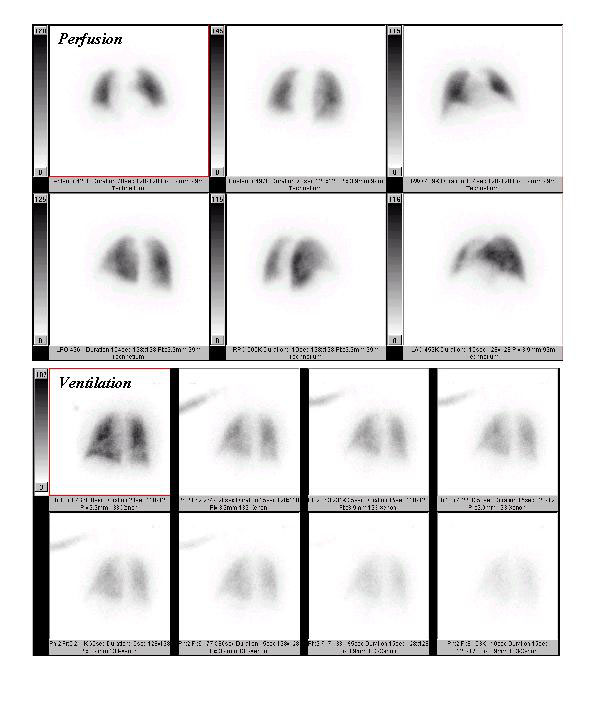A lung scan provides your doctor with images that show both the blood supply and the air supply to your lungs. The scan actually occurs in two steps. Blood supply—perfusion— is captured in the following way:
Air supply—ventilation—is captured in the following way:
A lung scan is generally used to detect pulmonary emboli—blood clots, air bubbles, or other foreign bodies—which can block the vessels that supply the lungs.
Your doctor will schedule the examination. When the exam is scheduled, your doctor must send a written order detailing the type of exam you should receive and the region of interest. You should also request a copy of this written order, and you should bring it with you to your appointment. According to Massachusetts state law, the technologist cannot inject the radiotracer without a written order from your doctor. Your examination will be delayed if we do not receive a written order.
When your examination is scheduled, your doctor will be told the time of the scan and the expected length of time for the complete examination. These times are provided to help you plan your visit to our laboratory. It is possible that your imaging appointment could change by as much as 1 hour, based on activity in the lab on the day of your appointment.
As you plan your visit to our lab, please remember that children under the age of 12 are not permitted within the Nuclear Medicine waiting room or laboratory areas.
There is no special preparation for a lung scan. The radiotracers are not known to cause any side effects or adverse interactions with food or prescription drugs. You should continue to take your prescribed medications.
If you are scheduled to have another examination on the same day as your lung scan, you should follow any preparations recommended for that study.
It is important that you have chest x-rays taken within 24 hours before your scheduled lung scan. These images help the nuclear medicine physician interpret the images from your lung scan. These images can be taken on the day of your lung scan appointment, but should be scheduled separately.
Before the study begins, any woman between the ages of 12 and 56 will be asked if she might be pregnant. If you think you might be pregnant you should talk to your doctor about it before having a nuclear medicine examination.
For the perfusion portion of the exam, the technologist will inject the appropriate dose of radiotracer into a vein in your arm. You will then be asked to lie on your back on the imaging bed. The cameras will be moved into position above and below the bed. The imaging session typically lasts 30 minutes.
For the ventilation portion of the scan, a breathing mask will be placed over your nose and mouth until the study is completed. You will breathe a special mixture of gases that includes a radioactive component. You will be directed to take a deep breath from the mask and hold it for as long as possible, then breathe normally as the images are taken. This imaging session typically lasts 15-20 minutes.
It is important that you remain still while the cameras are on—movement can ruin the images, and the nuclear medicine physician may have difficulty interpreting them accurately.
After the scan is complete, you will be able to resume normal daily activities. There will be no restrictions on eating or drinking. The radiotracers do not cause drowsiness, so you will be able to drive.
A nuclear medicine physician will review and interpret the images obtained during your study. The results of your lung scan will be provided to your doctor within 48 hours.
Most people do not experience any side effects from the radiotracer.
Nuclear medicine examinations do involve the use of a small amount of radiation. The tracer dose is calculated to minimize radiation exposure while providing accurate test results.
Nuclear medicine studies may not be appropriate for pregnant women or those who are breastfeeding. If you think you may be pregnant, discuss this with your doctor. Of course, it is always important to consider the benefits of any diagnostic study along with the risks. In some cases, the importance of making the correct diagnosis outweighs the potential risk to the unborn baby. Your doctor can explain your options.
If you are breastfeeding, you should not nurse your baby for approximately 36 hours after the radiotracer injection, since radiation can be passed through the breast milk. Prepare for your examination by pumping and saving milk for 24-48 hours before your examination, then bottle-feed your baby during the hours following your appointment.
The radiation injected during a nuclear medicine study is eliminated from you body through the kidneys. For that reason, you should drink plenty of fluids and urinate frequently following your examination.

Glossary terms
For over a century, a leader in patient care, medical education and research, with expertise in virtually every specialty of medicine and surgery.
About BWH